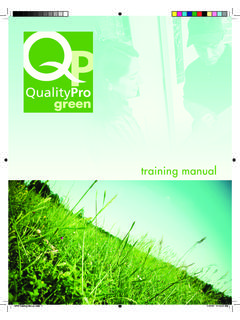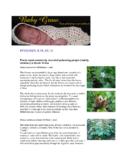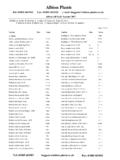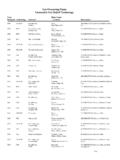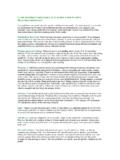Transcription of 2013 Pest Management Standards For Food Plants
1 2013 Pest Management Standards For food Plants i INTRODUCTION. T. he National Pest Management Association is pleased to release the 2013 Pest Manage- ment Standards for food Plants . Since 2007, these Standards have been the cornerstone of NPMA's Commercial Division activities. Of note in the 2013 revision is the move away from prescriptive instructions regarding place- ment and monitoring frequency of pest Management devices. Instead, a more results-oriented approach to pest Management , based on pest trends, inspection observations, and professional knowledge is embraced. As stated in previous editions, these Standards also do not preempt local, state, provincial, and/. or federal regulations. Any service provided must comply with government regulations or stat- utes governing pest Management , safety, and food protection. In addition, food Plants may have requirements more stringent than these Standards . By embracing these Standards , pest Management firms demonstrate the industry's role as protectors of food and property.
2 In addition to these Standards , a comprehensive online testing site can be found at This website includes the study guide and other resources noted in the Standards . Through this site, NPMA is working to provide the tools neces- sary for pest Management firms to comply with the Standards and raise the level of competency of pest Management professionals servicing food Plants . We hope that you find these Standards to be a beneficial addition to your own company proto- cols and procedures. As protectors of food and property, it is our industry's obligation to exceed expectations and demonstrate our role as a vital component to overall food safety. ii Table of Contents 1 Personnel Employee 2. 2. Security and Criminal Background 3. Plant Personnel 3. 4. 4. Minimum Training Standards for 5. Compliance with 6. 2 Pest Management Plan Rodent Program Exterior Property 8. Rodent Program-Interior 8. Rodent Program- Facility 9. Rodent Program- Frequency of 9. Rodent Program-Spacing of Rodent Management 10.
3 Rodent 11. Insect 11. Birds and 13. Weed 14. Pest Management 14. 14. food 15. Quality 15. Annual 15. Annual 16. 3 Communications 18. 4 Recordkeeping and Contracts 20. Labels and Safety Data 20. Pest Sighting 20. Licenses and 20. Service Protocols and Standard Operating 21. Service and Treatment 21. 5 National Organic Program Working in NOP 24. Appendix A Model Pest Management Inspection 26. Appendix B Current Good Manufacturing Practices (US FDA).. 27. iii definitions For definition purposes, Action Threshold means level of pest activity or pest damage that triggers a pest Management response. Company means the pest Management firm. Contact means the food plant contact person. Devices are any equipment used to monitor or control pests including, but not limited to, insect monitors, rodent bait stations, insect light traps, pheromone traps, and rodent Management stations. Employee means pest Management firm employee. Good Manufacturing Practices means the FDA's Current Good Manufacturing Practices in the United States, or equivalent outside of the Pest Management product means any lure, bait, monitoring product, pesticide, or any other formulated material used in performance of pest Management activities.
4 Plant means a food manufacturing facility including associated warehousing and does not include restaurants or other food service facilities. Rodent bait station means any station used for placement of solid rodenticide bait. Rodent Management station means any station used for monitoring or managing rodents. These include mechanical traps, rodent bait stations (see above), and other placed equipment for rodent Management . Technician means the pest Management firm employee providing service. iv Section 1. Personnel 1. SECTION 1: PERSONNEL. 1. SECTION. Employee Identification Reasoning This section sets forth minimum Standards for company employee identification so that the plant has a clear understanding of which personnel are from the pest Management firm to ensure that plant food safety and security are maintained. Standard All employees entering grounds of a food plant shall display photo identification to include: Employee name Employee identification number (if issued by the company).
5 Company name Company phone number Employee photo Date of issue The identification shall be displayed at all times while the employee is on site unless personnel practices set by the plant prohibit such badges. In addition, Plants may require other identification such as visitor badges and the employee must comply at all times with the visitor/. contractor policies of the plant. Uniforms Reasoning Uniforms are an important part of the plant safety and Standards program. Criteria set are designed to comply with the majority of food plant requirements for uniforms. Standard All employees who perform service work in food Plants shall wear uniforms meeting the plant's current requirements and at least the following criteria: Slip resistant sole shoes (safety toe if required by plant). Socks Long pants Shirt with sleeves (short or long) with company logo or company name Uniform closures shall be in compliance with plant requirements. A clean set of clothing shall be used in Plants if the previous account visited has exposed the clothing to contaminants.
6 These contaminants include but are not limited to chemical, microbiological, or allergens such as peanut products. More stringent requirements may be in place for individual Plants in addition to these Standards and service personnel must comply with those Standards . 2. SECTION 1: PERSONNEL. 1. SECTION. Security and Criminal Background Checks Reasoning Security is a major concern at all food Plants . This section is designed to ensure that personnel in food Plants have had proper background checks and that they comply with plant rules. Standard Any newly hired employee, including Management , entering a food plant shall have a criminal background check performed covering the previous five years prior to the date of hire. The checks shall be part of the records of the company and shall include all states or provinces in which the employee has lived and/or worked during the previous five years. Resulting action as a result of the check will be at the discretion of the company Management .
7 Some food Plants may have specific requirements and companies must comply with these requirements in addition to the above. Reminder: Companies must comply with government regulations related to obtaining background checks. Plants may also have policies regarding when an employee is permitted onsite and/or escorted. Companies should understand and comply with all plant policies and provide a written procedure to employees with a copy in the plant as to: Whether advanced notice must be given prior to arrival onsite Parking and vehicle use Substitute employees (technicians taking the place of previous technicians may have to be on a roster provided to the plant). Sign in policies Hours of operation when employees may have access Visitor badge policies Escort policies Restricted areas Access to locked or restricted areas via an assigned key, card, FOB, access code etc. Plant Personnel Practices Reasoning It is imperative that all employees entering a food plant property understand and comply with the plant personnel practices.
8 Besides being required by law, compliance is important as a part of food safety and also plant personnel morale. Standard All employees entering a food plant property must have reviewed and signed off on the Standards of the plant in terms of personnel practices as outlined by the plant. If a special set of Standards is in place for plant contractors, then the employee must comply with the Standards . If any questions or conflicts arise, the employee must notify their supervisor and the plant contact person. A copy of the signed document shall be maintained in the plant files. 3. SECTION 1: PERSONNEL. 1. SECTION. Vehicles Reasoning Plants have very specific requirements for vehicles both in terms of operations and in terms of security. This section sets the minimum for vehicle Standards . Standard All vehicles used for service must: Be clearly marked with company name Be properly licensed Have a current inspection if required by the state or province. Have adequate insurance coverage for bodily injury, property damage and any other coverage that may be required by the plant.
9 Be parked in properly assigned area Contain materials and equipment secured when unattended to restrict access. Drivers A five year motor vehicle background check must be completed for all new company employees who will drive on plant property. All drivers must have viewed the NPMA Safe Driving Video or participate in an insurance industry approved program annually and the company must retain safe driving training records as required by the insurance company. In addition, the vehicle must include at least the following equipment: First aid kit Spill control to cover all products on the vehicle Service Kit (carrying kit for small quantities of products and equipment). Change of clothing and/or coveralls Other equipment required by plant Safety Background Safety is a vital part of any pest Management program. The pest Management company and the food plant both must maintain safe working environments. Beyond just minimal regulatory requirements, policies must be in place to ensure a safe work environment.
10 Standard Each company must have a documented safety training of all employees working in food Plants . Safety training should include but is not limited to: Plant specific safety training The company and plant specific respiratory protection program Pesticide safety including the proper understanding of all labels of products to be used in the food plant, proper use, and disposal of products and containers Proper storage of products and equipment Emergency response procedures in case of spills 4. SECTION 1: PERSONNEL. 1. SECTION. Safety of other personnel near pest Management activities such as plant employees and consumers Ladder safety and transportation including tie down Use of fall prevention equipment Slip and fall prevention Lock out and tag out systems Shoe safety Personal protective equipment Definition of accident Accident and injury reporting requirements Fumigation plan (if fumigation is to be performed) (Note: in general, fumigation is not covered by these Standards ). Restricted areas in plant Confined space entry requirements Hazard communication Note: An optional safety manual is available for sale through the NPMA Resource Center which addresses safety program compliance and will provide guidelines for developing a safety program.

